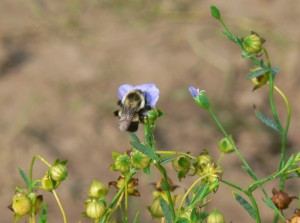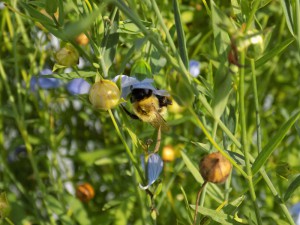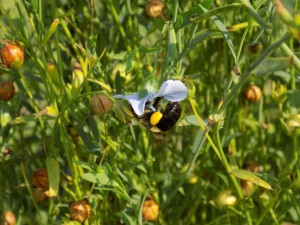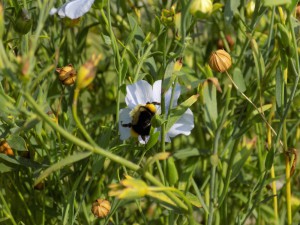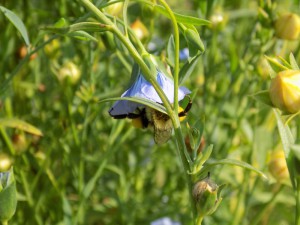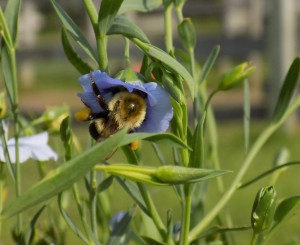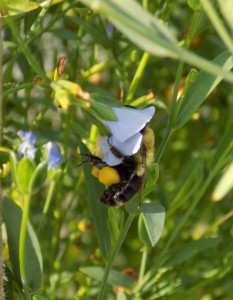This is yet another post in which I attempt to catch up on the wealth of observations from the summer’s flax project. In this post I will share a lot of photographs of bees. Photographing bees and other flying insects isn’t easy. However, my certainty that bees visit flax blossoms was the main reason that I was worried about cross-pollination when I was setting up my USDA seed project this spring. It’s the reason I covered the plants, even though flax is considered self-pollinated. I’m not sure what bees and other insects are doing, exactly, when they visit flax flowers. I just know that they do.
Here’s a bee visiting a flax flower on July 29, 2015.
I didn’t make note of what variety it was on.
The next photos are all from the same day, August 14, 2015, on the same variety, the type nicknamed Soctoss.
In all of the photos above, you can see the range of seed pod colors and maturity.
In the photo below you can see two very ripe pods, while the plant is still blooming away happily. Remember what I said about flax being indeterminate?!
The flowers of Soctoss are noticeably larger than other flax flowers. If anyone wanted to develop an ornamental fiber flax with showy flowers, they’d start with this one. In the photo below, I love how the little legs are clinging to the petals. You can almost hear the bee making happy yum-yum noises.
I’m only posting so many pictures because I feel gratified to have taken so many clear photos. I deleted just as many or more photos that were blurry. In the photo below new flower buds are forming.
This one is just too cute to not include.
In terms of data, I’m not sure what all these photos really prove or demonstrate. There were a limited number of bees on the flowers at that time, maybe 3, so I can’t really say how many bees visit flowers in a given period of time or over a given area. I’m not even sure if I ended up with lots of shots of the same bee, or these photos show all the bees that were active during those few minutes. I was just like, “Oo, there’s one! Ooh, there’s one!”
The other varieties were covered while I photographed this one, so there was no danger of cross-pollination in that moment. However, I see no reason why the bees wouldn’t have just flown to the next patch if it were uncovered. The bees clearly have full pollen sacs, but they seem to be guzzling nectar, judging by the total face-plant pose in most of the photos. I don’t know how to measure the degree to which pollen might have been spread inadvertently.
Anyway, in case anyone wants proof that insects visit flax flowers, here’s a little more photographic evidence.

